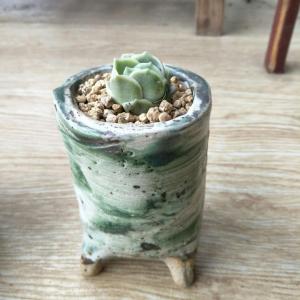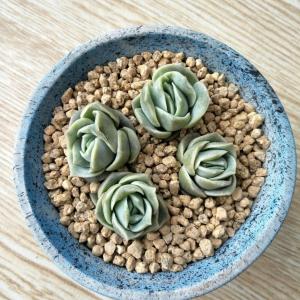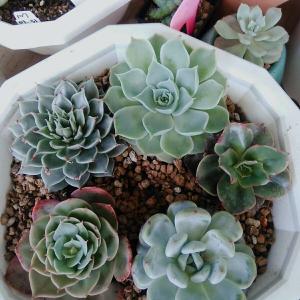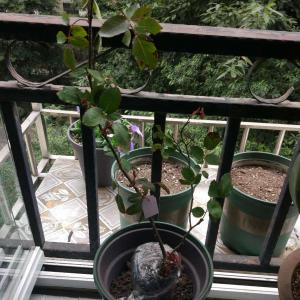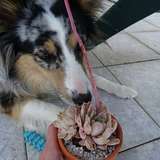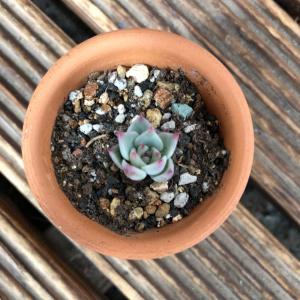文章
权问薇
2018年03月20日


正常环境需要3天至5天
所谓的正常环境就是适合此植物生长的环境,首先要维持温度在18度至28度之间,且无较强的阳光照晒,但是空气的流通性要好,在此环境中可以3天至5天浇一次水,也就是盆土上层有轻微偏干的情况出现时,就要时行浇水。

不同的环境不同的浇水时间
若温度升至28度以上时,此时要让土壤时刻都维持在偏潮湿的情况下,浇水的时间就要缩短,约2天左右进行一次浇水;若温度降至15度以下时,盆土上层要在偏干些方可时行浇水,约6天至8天时行一次浇水即可,且温度越低,浇水的间隔越长。

注意事项
虽然此植物喜水,但也不可浇水过多,否则会出现黄叶现象。严重时还会遭受其它病虫害的侵入。
当温度降至10度时,此时若浇水过多,很容易发生冻害,此时除了换环境养护外,还要减少浇水。
因为每个人的养殖环境不同,所以浇水也要变通,而且浇水前最好观察一下盆土的状态,根据盆土的实际情况来浇水才是最正确的做法。

0
0
文章
Miss Chen
2018年03月19日

Description: This herbaceous plant is a monocarpic perennial. It persists as a rosette of 3-30 basal leaves for 5-15 years (or more), finally bolting as a flowering plant that becomes 3-8' tall for a single season, and then dying. The basal leaves are up to 14" long and 4" across; they are oblong-elliptic to broadly oblong-elliptic in shape and smooth along their margins. The upper surfaces of the basal leaves are medium green and glabrous with prominent central veins; they are deciduous. The central stem of a flowering plant is light green to purple, glabrous, terete (circular in cross-section), rather stout, and unbranched. Along its entire length, there are whorls of 4-5 leaves (rarely more) that become gradually smaller in size as they ascend the central stem. Individual whorled leaves are 3-12" long and ¾-3" across; they are oblong-elliptic, oblong-lanceolate, or oblong-oblanceolate in shape with smooth margins. The upper surfaces of these leaves are dark green and glabrous with prominent central veins; they are also deciduous. The central stem terminates in a panicle of flowers up to 2' long (typically 50-100 flowers per panicle). This panicle is narrowly pyramidal in shape with spreading to ascending lateral branches. The terminal branches produce clusters of 2-6 flowers each on pedicels ¾-2" long.
Each flower is ¾-1¼" across, consisting of a shallow corolla with 4-5 spreading petaloid lobes, a shallow calyx with 4-5 spreading lobes, 4-5 stamens, and a superior ovary with a single style. Usually, the flowers are divided into 4 parts, rather than 5. The corolla lobes are oblong-lanceolate or oblong-elliptic in shape; they are mostly greenish white with purple specks or streaks, although their bases may be tinted pale yellow or pale pink. Toward the middle of each corolla lobe, there is a conspicuous nectar pad that is heavily fringed. The bases of these nectar pads are surrounded by rings of green. The calyx and its lobes are medium green and glabrous; individual lobes are linear-lanceolate and up to ½" long. The superior ovary is light green. The peduncle, lateral branches, and pedicels of the inflorescence are light green to purple, glabrous, and terete. At locations where there are divergent branches within the inflorescence, there are pairs of leafy bracts about 1-3" long that are linear-lanceolate or linear-oblong in shape. The blooming period occurs from late spring to early summer, lasting about 3 weeks. The flowers within a panicle bloom at about the same time. Individual plants in a colony have a tendency to bloom synchronically (during the same year at the same time), which facilitates cross-pollination of the flowers. Afterwards, the flowers are replaced by ovoid seed capsules about ½-¾" in length; these capsules are strongly beaked from the persistent styles. At maturity, these capsules become dark brown and split open to release their seeds. Each capsule contains 4-14 dark brown seeds that are crescent-shaped and winged. The root system consists of a fleshy taproot.

Cultivation: The preference is full sun to light shade, mesic to dry-mesic conditions, and calcareous soil that is loamy, rocky, or sandy. The seeds require a dormant period with cool moist stratification in order to germinate. Because this plant persists as a rosette of basal leaves for several years, it is slow to develop, and its seeds are not often available commercially. Problems with disease organisms or insect pests rarely occur.
Range & Habitat: The native American Columbo is occasional in the southern half of Illinois, rare (or possibly extirpated) in NE Illinois, and absent from the rest of the state (see Distribution Map). Illinois lies along the NW range limit of this species. Habitats include upland savannas, upland woodlands, wooded slopes, limestone and sandstone glades, woodland openings, and small meadows in upland wooded areas. In areas near southern Lake Michigan, this plant occurs in similar habitats with calcareous sand. American Columbo is often associated with upland oak trees and such ferns as Asplenium platyneuron (Ebony Spleenwort) and Polystichum acrostichoides (Christmas Fern). It is found in higher quality natural areas.
Faunal Associations: The flowers are cross-pollinated primarily by such long-tongued bees as honeybees, bumblebees, and Anthophorine bees (Anthophora spp.); these insects obtain mostly nectar from the flowers. Aside from these pollinators, there are few records of floral-faunal relationships for American Columbo. The basal leaves of more western species in the same genus, sometimes referred to as 'Elkweed,' are eaten occasionally by elk and other hoofed mammalian herbivores. However, evidence of such browsing hasn't been observed by the author for the more eastern American Columbo.

Photographic Location: A rocky wooded slope in southern Illinois and an upland woodland in east-central Illinois.
Comments: American Columbo is an unusual native plant that has a tall striking appearance when it finally bolts and blooms. The greenish white flowers with purplish specks or streaks have an odd appearance; they are produced in great abundance during the blooming period. Even though the flowers of American Columbo have conspicuous nectar pads like some species in the Lily family (Liliaceae), such as Melanthium virginicum (Virginia Bunchflower) and Veratrum woodii (False Hellebore), it is not closely related to these latter species (the former species is a dicot, while the latter are monocots). The Frasera genus is a small group of plants that are found primarily in western North America. American Columbo is the only eastern species, making flowering plants easy to identity. Immature plants consisting of basal leaves, however, can be confused with the immature stage of False Hellebore. An obsolete scientific name for American Columbo is Swertia caroliniensis.
Each flower is ¾-1¼" across, consisting of a shallow corolla with 4-5 spreading petaloid lobes, a shallow calyx with 4-5 spreading lobes, 4-5 stamens, and a superior ovary with a single style. Usually, the flowers are divided into 4 parts, rather than 5. The corolla lobes are oblong-lanceolate or oblong-elliptic in shape; they are mostly greenish white with purple specks or streaks, although their bases may be tinted pale yellow or pale pink. Toward the middle of each corolla lobe, there is a conspicuous nectar pad that is heavily fringed. The bases of these nectar pads are surrounded by rings of green. The calyx and its lobes are medium green and glabrous; individual lobes are linear-lanceolate and up to ½" long. The superior ovary is light green. The peduncle, lateral branches, and pedicels of the inflorescence are light green to purple, glabrous, and terete. At locations where there are divergent branches within the inflorescence, there are pairs of leafy bracts about 1-3" long that are linear-lanceolate or linear-oblong in shape. The blooming period occurs from late spring to early summer, lasting about 3 weeks. The flowers within a panicle bloom at about the same time. Individual plants in a colony have a tendency to bloom synchronically (during the same year at the same time), which facilitates cross-pollination of the flowers. Afterwards, the flowers are replaced by ovoid seed capsules about ½-¾" in length; these capsules are strongly beaked from the persistent styles. At maturity, these capsules become dark brown and split open to release their seeds. Each capsule contains 4-14 dark brown seeds that are crescent-shaped and winged. The root system consists of a fleshy taproot.

Cultivation: The preference is full sun to light shade, mesic to dry-mesic conditions, and calcareous soil that is loamy, rocky, or sandy. The seeds require a dormant period with cool moist stratification in order to germinate. Because this plant persists as a rosette of basal leaves for several years, it is slow to develop, and its seeds are not often available commercially. Problems with disease organisms or insect pests rarely occur.
Range & Habitat: The native American Columbo is occasional in the southern half of Illinois, rare (or possibly extirpated) in NE Illinois, and absent from the rest of the state (see Distribution Map). Illinois lies along the NW range limit of this species. Habitats include upland savannas, upland woodlands, wooded slopes, limestone and sandstone glades, woodland openings, and small meadows in upland wooded areas. In areas near southern Lake Michigan, this plant occurs in similar habitats with calcareous sand. American Columbo is often associated with upland oak trees and such ferns as Asplenium platyneuron (Ebony Spleenwort) and Polystichum acrostichoides (Christmas Fern). It is found in higher quality natural areas.
Faunal Associations: The flowers are cross-pollinated primarily by such long-tongued bees as honeybees, bumblebees, and Anthophorine bees (Anthophora spp.); these insects obtain mostly nectar from the flowers. Aside from these pollinators, there are few records of floral-faunal relationships for American Columbo. The basal leaves of more western species in the same genus, sometimes referred to as 'Elkweed,' are eaten occasionally by elk and other hoofed mammalian herbivores. However, evidence of such browsing hasn't been observed by the author for the more eastern American Columbo.

Photographic Location: A rocky wooded slope in southern Illinois and an upland woodland in east-central Illinois.
Comments: American Columbo is an unusual native plant that has a tall striking appearance when it finally bolts and blooms. The greenish white flowers with purplish specks or streaks have an odd appearance; they are produced in great abundance during the blooming period. Even though the flowers of American Columbo have conspicuous nectar pads like some species in the Lily family (Liliaceae), such as Melanthium virginicum (Virginia Bunchflower) and Veratrum woodii (False Hellebore), it is not closely related to these latter species (the former species is a dicot, while the latter are monocots). The Frasera genus is a small group of plants that are found primarily in western North America. American Columbo is the only eastern species, making flowering plants easy to identity. Immature plants consisting of basal leaves, however, can be confused with the immature stage of False Hellebore. An obsolete scientific name for American Columbo is Swertia caroliniensis.
0
0
文章
Miss Chen
2018年03月18日

Description: This perennial wildflower consists of a rosette of basal leaves that produces a single flowering stalk about ½–2' tall. The basal leaves are up to 5" long and 3" across; they are oval to obovate in shape, medium green on their upper surfaces, and bluntly dentate toward their tips. The alternate cauline leaves are smaller in size than the basal leaves; they are oblanceolate to oblong and clasp the flowering stalk. Both the basal and cauline leaves are more or less pubescent, particularly on their undersides.
The stout flowering stalk is terete, conspicuously hairy, and unbranched; it terminates in a corymb of several daisy-like flowerheads (typically 1-6 flowerheads, but sometimes more). Each flowerhead is ¾–1¼" across, consisting of 50-100 ray florets that surround numerous yellow disk florets in the center. The ray florets are usually white, less often they are light pink or light violet. The base of each flowerhead has an outer surface consisting of numerous green bracts (phyllaries); these floral bracts are linear in shape and organized into a single series. The blooming period occurs from mid-spring to early summer and lasts about 2-3 weeks. Both the ray and disk florets are fertile, each one producing a single bullet-shaped achene with a tuft of white hairs. These achenes are distributed by the wind. After the blooming period, the flowering stalks die down, but the basal leaves persist. The root system consists of a crown of fibrous roots; rhizomes or stolons are often produced, resulting in small colonies of plants.

Cultivation: The preference is dappled sunlight or partial sun and average to dry conditions. Different kinds of soil are acceptable, including those that contain clay-loam, rocky material, or sand. The best site consists of a partially shaded slope under trees where the ground vegetation is somewhat sparse.
Range & Habitat: The native Robin's Plantain is occasional throughout Illinois in suitable habitats, but it is more common in the northern and west-central sections of the state than elsewhere (see Distribution Map). Habitats include open rocky woodlands, wooded sand dunes, slopes of wooded bluffs, savannas and sandy savannas, banks of streams, and clearings in wooded areas. Robin's Plantain is found in less disturbed areas than other species in this genus.
Faunal Associations: The flowerheads attract small bees, various flies, small butterflies, and skippers. These insects seek nectar primarily, although some of the bees also collect pollen. The caterpillars of several moths feed on the flowers of Erigeron spp. (Fleabanes), including Schinia lynx (Lynx Flower Moth), Schinia obscurata (Obscure Flower Moth), Eupithecia miserulata (Common Pug), and Synchlora aerata (Wavy-Lined Emerald). Some aphids that feed on species in this genus include Aphis middletonii (Erigeron Root Aphid) and Prociphilus erigeronensis. The foliage is palatable to mammalian herbivores (rabbits, deer, livestock, etc.), while the seeds are eaten to a limited extent by the White-Footed Mouse and other small rodents.

Photographic Location: The photograph of the flowerheads was taken at the webmaster's wildflower garden in Urbana, Illinois, while the photograph of the basal leaves was taken on the slope of a wooded bluff in Vermilion County, Illinois.
Comments: The flowerheads of Robin's Plantain are slightly larger than those of other Erigeron spp. (Fleabanes) and rather showy. Other fleabanes in the state are rather weedy annual or biennial species that lack the basal leaves of Robin's Plantain; they usually bloom a little later during the early summer and can be found in sunny habitats with a history of disturbance.
The stout flowering stalk is terete, conspicuously hairy, and unbranched; it terminates in a corymb of several daisy-like flowerheads (typically 1-6 flowerheads, but sometimes more). Each flowerhead is ¾–1¼" across, consisting of 50-100 ray florets that surround numerous yellow disk florets in the center. The ray florets are usually white, less often they are light pink or light violet. The base of each flowerhead has an outer surface consisting of numerous green bracts (phyllaries); these floral bracts are linear in shape and organized into a single series. The blooming period occurs from mid-spring to early summer and lasts about 2-3 weeks. Both the ray and disk florets are fertile, each one producing a single bullet-shaped achene with a tuft of white hairs. These achenes are distributed by the wind. After the blooming period, the flowering stalks die down, but the basal leaves persist. The root system consists of a crown of fibrous roots; rhizomes or stolons are often produced, resulting in small colonies of plants.

Cultivation: The preference is dappled sunlight or partial sun and average to dry conditions. Different kinds of soil are acceptable, including those that contain clay-loam, rocky material, or sand. The best site consists of a partially shaded slope under trees where the ground vegetation is somewhat sparse.
Range & Habitat: The native Robin's Plantain is occasional throughout Illinois in suitable habitats, but it is more common in the northern and west-central sections of the state than elsewhere (see Distribution Map). Habitats include open rocky woodlands, wooded sand dunes, slopes of wooded bluffs, savannas and sandy savannas, banks of streams, and clearings in wooded areas. Robin's Plantain is found in less disturbed areas than other species in this genus.
Faunal Associations: The flowerheads attract small bees, various flies, small butterflies, and skippers. These insects seek nectar primarily, although some of the bees also collect pollen. The caterpillars of several moths feed on the flowers of Erigeron spp. (Fleabanes), including Schinia lynx (Lynx Flower Moth), Schinia obscurata (Obscure Flower Moth), Eupithecia miserulata (Common Pug), and Synchlora aerata (Wavy-Lined Emerald). Some aphids that feed on species in this genus include Aphis middletonii (Erigeron Root Aphid) and Prociphilus erigeronensis. The foliage is palatable to mammalian herbivores (rabbits, deer, livestock, etc.), while the seeds are eaten to a limited extent by the White-Footed Mouse and other small rodents.

Photographic Location: The photograph of the flowerheads was taken at the webmaster's wildflower garden in Urbana, Illinois, while the photograph of the basal leaves was taken on the slope of a wooded bluff in Vermilion County, Illinois.
Comments: The flowerheads of Robin's Plantain are slightly larger than those of other Erigeron spp. (Fleabanes) and rather showy. Other fleabanes in the state are rather weedy annual or biennial species that lack the basal leaves of Robin's Plantain; they usually bloom a little later during the early summer and can be found in sunny habitats with a history of disturbance.
0
0
文章
Miss Chen
2018年03月18日

Description: This is a herbaceous vine about 5-30' long that branches occasionally. Its slender stems have the capacity to twine around adjacent vegetation and fences, climbing upward and outward. The glabrous stems are light green, pale yellow, reddish green, or dark red. The stems are usually terete; less often, they are bluntly angular or narrowly ridged. Whorled and/or opposite leaves sometimes occur near the base of the vine, otherwise the leaves are alternate. At maturity, individual leaf blades are 2-4" long and 1½-3" across; they are narrowly cordate to cordate, smooth along their margins, and palmately veined (7-11 veins per leaf). The upper blade surface is medium green and glabrous, while the lower surface is pale green and sparsely short-pubescent (less often, glabrous or densely short-pubescent). Very young leaf blades are golden green in appearance. The slender petioles are 1½-6" long, light green to dark red, and glabrous or nearly so; sometimes there are tufts of hair where the petioles join the leaf blades. The leaf blades tend to hang downward from their petioles.
Wild Yam is dioecious, producing vines with either all male flowers or all female flowers. On male vines, panicles of numerous male flowers about 4-12" long develop from the leaf axils. Male flowers are arranged in small clusters of 1-3 along the branches of each panicle. Individual male flowers are about 1/8" (3 mm.) across, consisting of 6 whitish green or yellowish green tepals and 6 fertile stamens. On female vines, racemes of 5-15 female flowers about 3-9" long develop from the leaf axils. Individual female flowers are about 1/8" (3 mm.) across and 1/3" (8 mm.) long, consisting of 6 whitish green or yellowish green tepals and a large inferior ovary with 6 infertile stamens. The blooming period occurs during early summer. The female flowers are replaced by 3-celled seed capsules that are ovoid in shape and about 1" long; these capsules are strongly 3-angled and become golden green as they mature. Each cell of the capsule usually contains 2 seeds (less often, only 1). The flattened seeds have broad membranous wings; they are distributed by the wind. The root system is rhizomatous.

Cultivation: The preference is partial to full sun, moist to mesic conditions, and soil consisting of loam or sandy loam. This vine can survive in light shade, but it is less likely to produce flowers and seed capsules. There are very few problems with insects and disease organisms.
Range & Habitat: The native Wild Yam is occasional to locally common in Illinois; it is found in every county (see Distribution Map). Habitats include thinly wooded bluffs, typical savannas and sandy savannas, woodland borders, typical thickets and sandy thickets, moist sand prairies, powerline and railroad clearances in wooded areas, and fence rows. Wild Yam is found in both high quality and degraded habitats; it benefits from occasional wildfires and other kinds of disturbance that reduce competition from overhead canopy trees.
Faunal Associations: There is very little information about floral-faunal relationships for this species. The foliage appears to be avoided as a food source by mammalian herbivores. Dense tangles of this vine can enhance nesting habitat for birds and provide cover for various animals.

Photographic Location: The photograph of leaf blades was taken along a fence row in Vermilion County, Illinois, while the photographs of the seed capsules and flowers were taken in moist sandy thickets of the Indiana Dunes National Lakeshore in NW Indiana.
Comments: Like the somewhat similar Greenbriers and Carrion Flowers (Smilax spp.), Wild Yam is a monocot, rather than a dicot. This vine is related to the tropical Yam that is found in grocery stores, but it does not produce edible tubers. Wild Yam can be readily distinguished from similar vines by the palmate venation of its leaves, its racemes or panicles of tiny flowers, and its conspicuous 3-angled seed capsules. In southern Illinois, there is the very similar Dioscorea quaternata (Whorled Wild Yam), which tends to have more whorled leaves than the common Wild Yam that is described here. There is disagreement among authorities regarding the taxonomic status of Whorled Wild Yam: While some authorities regard it as a distinct species (e.g., Mohlenbrock, 2003), other authorities consider it to be merely a variety of Wild Yam, and still others think it is unworthy of any taxonomic recognition.
Wild Yam is dioecious, producing vines with either all male flowers or all female flowers. On male vines, panicles of numerous male flowers about 4-12" long develop from the leaf axils. Male flowers are arranged in small clusters of 1-3 along the branches of each panicle. Individual male flowers are about 1/8" (3 mm.) across, consisting of 6 whitish green or yellowish green tepals and 6 fertile stamens. On female vines, racemes of 5-15 female flowers about 3-9" long develop from the leaf axils. Individual female flowers are about 1/8" (3 mm.) across and 1/3" (8 mm.) long, consisting of 6 whitish green or yellowish green tepals and a large inferior ovary with 6 infertile stamens. The blooming period occurs during early summer. The female flowers are replaced by 3-celled seed capsules that are ovoid in shape and about 1" long; these capsules are strongly 3-angled and become golden green as they mature. Each cell of the capsule usually contains 2 seeds (less often, only 1). The flattened seeds have broad membranous wings; they are distributed by the wind. The root system is rhizomatous.

Cultivation: The preference is partial to full sun, moist to mesic conditions, and soil consisting of loam or sandy loam. This vine can survive in light shade, but it is less likely to produce flowers and seed capsules. There are very few problems with insects and disease organisms.
Range & Habitat: The native Wild Yam is occasional to locally common in Illinois; it is found in every county (see Distribution Map). Habitats include thinly wooded bluffs, typical savannas and sandy savannas, woodland borders, typical thickets and sandy thickets, moist sand prairies, powerline and railroad clearances in wooded areas, and fence rows. Wild Yam is found in both high quality and degraded habitats; it benefits from occasional wildfires and other kinds of disturbance that reduce competition from overhead canopy trees.
Faunal Associations: There is very little information about floral-faunal relationships for this species. The foliage appears to be avoided as a food source by mammalian herbivores. Dense tangles of this vine can enhance nesting habitat for birds and provide cover for various animals.

Photographic Location: The photograph of leaf blades was taken along a fence row in Vermilion County, Illinois, while the photographs of the seed capsules and flowers were taken in moist sandy thickets of the Indiana Dunes National Lakeshore in NW Indiana.
Comments: Like the somewhat similar Greenbriers and Carrion Flowers (Smilax spp.), Wild Yam is a monocot, rather than a dicot. This vine is related to the tropical Yam that is found in grocery stores, but it does not produce edible tubers. Wild Yam can be readily distinguished from similar vines by the palmate venation of its leaves, its racemes or panicles of tiny flowers, and its conspicuous 3-angled seed capsules. In southern Illinois, there is the very similar Dioscorea quaternata (Whorled Wild Yam), which tends to have more whorled leaves than the common Wild Yam that is described here. There is disagreement among authorities regarding the taxonomic status of Whorled Wild Yam: While some authorities regard it as a distinct species (e.g., Mohlenbrock, 2003), other authorities consider it to be merely a variety of Wild Yam, and still others think it is unworthy of any taxonomic recognition.
0
0
文章
Miss Chen
2018年03月18日

Description: This perennial plant is about 2½–5' tall, branching occasionally and more or less erect. The stems are variably hairy, sometimes having hairs that occur in lines along their length. These hairs are white and either straight or somewhat curved, but not conspicuously hooked. The compound leaves alternate along the stems; they are trifoliate. The petioles of the compound leaves are about ½–1½" in length. At the base of each petiole is a pair of inconspicuous stipules that are deciduous and at least 5 times longer than they are wide. The leaflets are about 1½–3½" long and about half as much across. They are ovate-lanceolate or ovate and have smooth margins. The base of each leaflet is quite rounded. The upper surface of each leaflet is green or dark green, and nearly glabrous or finely pubescent. The lower surface is light green and faintly reticulate. There are usually fine hairs on the lower leaf surface, especially along the major veins, but the amount is variable.

The upper stems terminate in panicles of light pink to purplish pink flowers. The larger panicles can be 1-2' long and have spreading stems that produce numerous flowers. Each flower is about ¼" long. These flowers have a typical structure for members of the Bean family, consisting of a hood and projecting keel. Near the center of each flower is a patch of white that is surrounded by a thin line of purple. The blooming period can occur from mid-summer to early fall, and lasts about a month. There is no floral scent. Each fertilized flower is replaced by a flat loment (a type of seedpod) consisting of 2-5 rounded segments. These loments are about ¾–1½" long and covered with clinging hairs. The root system consists of a taproot and nodule-forming secondary roots. This plant spreads by reseeding itself.
Cultivation: The preference is partial sun and mesic to slightly dry conditions. This plant usually grows in soil that contains loam, clay-loam, or some kind of rocky material. It does not appear to be affected by powdery mildew to the same extent as Desmodium canadense (Showy Tick Trefoil). Nitrogen is added to the soil through the root nodules.

Range & Habitat: Perplexing Tick Trefoil occurs occasionally in the majority of counties in Illinois; this native plant is a little more common in the southern half of the state than in the northern half (see Distribution Map). The map doesn't distinguish between the distribution of Desmodium perplexum and Desmodium glabellum. Habitats include savannas, rocky upland forests, edges of wooded areas, thickets, and limestone glades.
Faunal Associations: Like other Desmodium spp., long-tongued bees are the primary pollinators of the flowers. Typical visitors include bumblebees, long-horned bees (Melissodes spp.), and leaf-cutting bees (Megachile spp.). These insects collect pollen. The caterpillars of the skippers, Thorybes pylades (Northern Cloudywing) and Thorybes bathyllus (Southern Cloudywing), feed on the foliage. The seeds are eaten by some upland gamebirds and small rodents, including the Bobwhite, Wild Turkey, and White-footed Mouse. Mammalian herbivores eat Tick Trefoils readily, including deer, rabbits, groundhogs, and livestock. These mammals help to distribute the seeds as the loments readily cling to their fur. The loments also cling to the clothing of humans.
Photographic Location: The edge of a wooded area in Judge Webber Park, Urbana, Illinois.
Comments: This Tick Trefoil species can produce large panicles of small flowers that are rather showy. It is one of the Desmodium spp. that blooms later in the year than many others. Unfortunately, it has been re-classified by taxonomists on several occasions, which may be the reason for the 'perplexum' in its scientific name. In some older sources of information, this plant is referred to as Desmodium dillenii and Desmodium glabellum. However, Desmodium glabellum is now considered a separate species with an appearance that is quite similar to Perplexing Tick Trefoil, while Desmodium dillenii is considered a defunct classification. Presumably, Desmodium perplexum and Desmodium glabellum can be distinguished as follows: 1) the former species has a faint reticulated network of veins on the lower surface of the leaflets, while the latter has a strong reticulated network of veins, and 2) the former species has hairs on the stems and leaves that are straight or somewhat curved, while the latter has hooked hairs. Other distinguishing features for Perplexing Tick Trefoil include inconspicuous stipules that are very narrow and deciduous (i.e., they wither away quickly), and petioles of the compound leaves that are at least ½" in length.

The upper stems terminate in panicles of light pink to purplish pink flowers. The larger panicles can be 1-2' long and have spreading stems that produce numerous flowers. Each flower is about ¼" long. These flowers have a typical structure for members of the Bean family, consisting of a hood and projecting keel. Near the center of each flower is a patch of white that is surrounded by a thin line of purple. The blooming period can occur from mid-summer to early fall, and lasts about a month. There is no floral scent. Each fertilized flower is replaced by a flat loment (a type of seedpod) consisting of 2-5 rounded segments. These loments are about ¾–1½" long and covered with clinging hairs. The root system consists of a taproot and nodule-forming secondary roots. This plant spreads by reseeding itself.
Cultivation: The preference is partial sun and mesic to slightly dry conditions. This plant usually grows in soil that contains loam, clay-loam, or some kind of rocky material. It does not appear to be affected by powdery mildew to the same extent as Desmodium canadense (Showy Tick Trefoil). Nitrogen is added to the soil through the root nodules.

Range & Habitat: Perplexing Tick Trefoil occurs occasionally in the majority of counties in Illinois; this native plant is a little more common in the southern half of the state than in the northern half (see Distribution Map). The map doesn't distinguish between the distribution of Desmodium perplexum and Desmodium glabellum. Habitats include savannas, rocky upland forests, edges of wooded areas, thickets, and limestone glades.
Faunal Associations: Like other Desmodium spp., long-tongued bees are the primary pollinators of the flowers. Typical visitors include bumblebees, long-horned bees (Melissodes spp.), and leaf-cutting bees (Megachile spp.). These insects collect pollen. The caterpillars of the skippers, Thorybes pylades (Northern Cloudywing) and Thorybes bathyllus (Southern Cloudywing), feed on the foliage. The seeds are eaten by some upland gamebirds and small rodents, including the Bobwhite, Wild Turkey, and White-footed Mouse. Mammalian herbivores eat Tick Trefoils readily, including deer, rabbits, groundhogs, and livestock. These mammals help to distribute the seeds as the loments readily cling to their fur. The loments also cling to the clothing of humans.
Photographic Location: The edge of a wooded area in Judge Webber Park, Urbana, Illinois.
Comments: This Tick Trefoil species can produce large panicles of small flowers that are rather showy. It is one of the Desmodium spp. that blooms later in the year than many others. Unfortunately, it has been re-classified by taxonomists on several occasions, which may be the reason for the 'perplexum' in its scientific name. In some older sources of information, this plant is referred to as Desmodium dillenii and Desmodium glabellum. However, Desmodium glabellum is now considered a separate species with an appearance that is quite similar to Perplexing Tick Trefoil, while Desmodium dillenii is considered a defunct classification. Presumably, Desmodium perplexum and Desmodium glabellum can be distinguished as follows: 1) the former species has a faint reticulated network of veins on the lower surface of the leaflets, while the latter has a strong reticulated network of veins, and 2) the former species has hairs on the stems and leaves that are straight or somewhat curved, while the latter has hooked hairs. Other distinguishing features for Perplexing Tick Trefoil include inconspicuous stipules that are very narrow and deciduous (i.e., they wither away quickly), and petioles of the compound leaves that are at least ½" in length.
0
0




